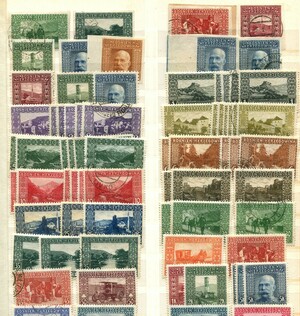DUPLICATES

"Swaps" as schoolboy collectors used to call them, "duplicates" as regarded by established older collectors, become "research material" and cherished by specialist collectors.
Many of my customers are in the middle category. Collections are an excellent way to build a collection for a while, at very reasonable cost, but there comes a time - especially when filling a standard printed album - when a lot of stamps in a new collection, just purchased, can look suspiciously like the old friends already gracing an existing collection. What to do with them? A club auction or a smaller local stamp auction is a good solution to dispose of duplicates. Some of my clients also contribute to exchange packets.
A sideways-thinking solution is to consider starting a new country. This way, new purchases are full of interest with nothing to discard.
The other solution is to become more specialist. For instance, if you collect Bosnia, a page of duplicates are worth a second glance, in fact hours of study. The Stamp Printing works in Vienna had many perforating machines, set to different gauges, and used at random, just whenever a machine became free on the factory floor. So, the charming engraved pictorial issues of 1906 illustrated here deserve more attention. A close look will reveal many different perforations from 9½ to 13½, several imperfs, plus maybe some rarer compounds, and maybe, further on, even the unwieldy perf 6.
One of my customers collects Hungary - just the 1874 "Letter" design and the 1900 "Turul" eagle design. Nothing else. For years he has taken every lot I can offer in this period, and wants more. The printers of Hungarian stamps at the turn of the century had many perforating machines of different gauges, several watermarks were used as well as different paper types, there are stereotypes and electrotypes for the printing plates, then there are shades, and of course postmarks....so every bunch of "standard" printed album pages bearing these stamps in fact offers hundreds, maybe thousands, of possibilities, many quite rare.
Duplicates have become specialist study material. Even detailed listings in Gibbons or Michel do not quite tell the full story, and it is possible to make finds which are outside the scope of the normal catalogue listings. At this level, duplicates are best saved for empirical research as one's knowledge grows. A mass of previously "checked" duplicates can become a source of new finds as one's knowledge grows over the years.
- Published
- 27/09/21 12:48:00 PM
